Bearded irises: varieties, planting and care

Irises are perennial and picky flowers. They have unusual inflorescences, bright color of petals, long and straight leaves. Delicate characteristic aroma, fresh and delicate. The petals of the bearded iris, diverging up and down, form a crown and a collar with a double beard, which is why the flower got its name. In the article we will consider the varieties, the nuances of planting and caring for bearded irises.

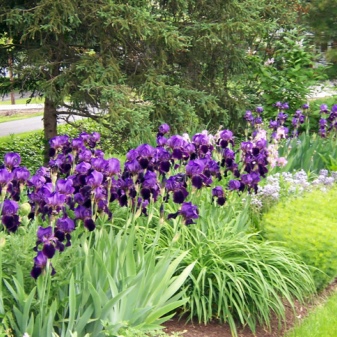
Varieties
Bearded irises are a culture with a well-developed root of 1.5-2 cm in thickness. On the rhizome, thickenings can be seen over the years of the life of the bush. In some varieties, the smell of root thickening resembles a violet. The leaves are bright, with a grayish tint, flat and sharp. The branched peduncle is straight, forms several buds. Six petals: three raised up - these are standards, and three down in an arc - these are fouls.
Bearded irises were named after the characteristic accumulation of hairs at the base of the petals, collected in long beards. By the number of different varieties, it is considered the largest group.
More than 30 thousand different hybrids have been obtained from 50 different varieties of bearded irises. Irises are distinguished by color, bush height and flowering period.
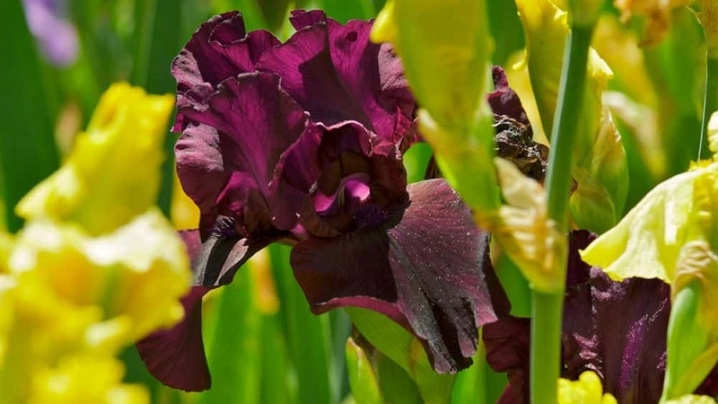
At the beginning of flowering, there are:
- very early - VE;
- early - E;
- medium - M;
- late - L;
- very late - VL;
- long flowering - EML (remontant).
This abbreviation in the catalog and on the packaging denotes the flowering time.
Irises differ in flower size:
- with small flowers;
- with averages;
- with large;
- with the largest.


Bearded irises in peduncle height are:
- miniature dwarf 20 cm - MDB;
- standard dwarf 20–40 cm - SDB;
- intermediate bearded 40–70 cm - IB;
- curbs 40–70 cm - BB;
- miniature high 40–70 cm - MTB;
- high - TB.
The height of the peduncle is indicated on the box with rhizomes for planting in Latin letters.

By color, they are classified according to varieties:
- one-color;
- two-tone;
- two-color;
- bordered;
- iridescent.
There are cosmic irises, three-dimensionally decorated with petals, corrugated - wavy petals, lacy - waves along the edge resemble lace.


Names and descriptions of the best varieties of bearded irises
"Kopatonic"
The flowering period is from May to June and lasts about 2-3 weeks. It reaches a height of 85 cm, it is a tall variety. Large flowers from 10-15 cm in diameter are painted in ruby-red shades with a bright reddish border and mustard-yellow beard, colors often vary from orange to brownish. Forms corrugated lace flowers, 7–8 on one peduncle.
This hybrid variety has high winter hardiness. The distance between mature bushes should be 40-60 cm. Strongly overgrown irises of this variety stop blooming.

Devil's lake
This tall iris reaches a height of 100 cm. It begins to bloom in July, has a dark blue monochromatic color of the petals. The stem can have up to 4 branches and 6–8 flowers are formed. The diameter of a very large flower is about 11–18 cm. The petals are covered with light corrugated ripples. The color of the beard is blue, at the core it is yellow.
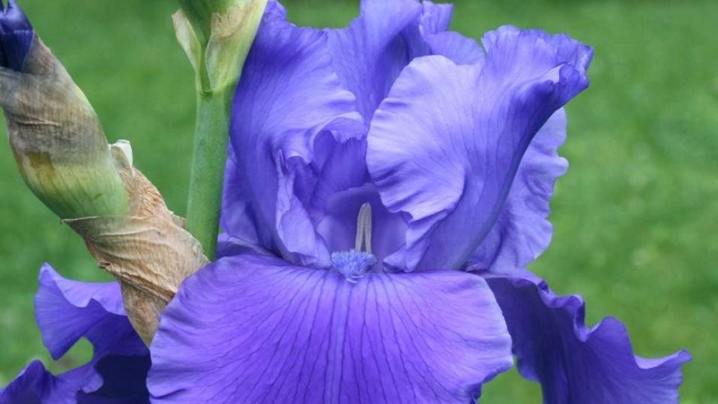
"Wabash"
This is a kind of bearded iris 70–90 cm high. The fragrant flowers are painted in two shades: the upper ones are pale white, the lower ones are bright purple with a white border. The beard is yellowish. 8-9 flowers are formed on one bush in June. It is a cold-hardy, winter-hardy variety that does not succumb to pests and diseases.... Old plants do not even need to be covered for the winter in the middle lane, with the exception of a snowless winter.
It tolerates light shading well, but must be protected from strong winds. The soil before planting requires preparation of the drainage system, irises "Wabash" do not withstand an excess of moisture. The soil for planting is neutral or slightly acidic.

"Decadence"
It begins to bloom in June. The height of adult plants reaches 95 cm. The flowers are large, two-colored, fan-shaped with three drooping petals. Light yellow crown and burgundy-cherry lower petals with golden corrugated border. Short mandarin-colored beard. Photophilous, but prefers light partial shade at noon... Recommended to be planted on the site, where the sun is about 5 hours a day. It tolerates acidic, clayey, loamy and sandy soils well.

World premier
Flowering begins in June and continues in July. Tall bushes with peduncles up to 90 cm give large flowers 13-15 cm, up to 6 pieces on each plant. The upper petals are lilac-blue, and the lower ones are deep blue with a blue edging. Dark gold beard. Blooms for several weeks, individual specimens - from 1 to 5 days. Prefers neutral soils: loose, sandy-clayey, slightly humus. The distance between plants is 30 cm.
In hot weather, flowering can begin earlier than usual and does not last long.

"Supreme Sultan"
The unpretentious variety has a long flowering period from June to July. Loves sunny, sheltered from the wind places... Reaches a height of 100 cm. Huge flowers up to 19 cm are painted in two colors: an orange-saffron top is combined with falling petals in mahogany shades. The beard resembles the tongues of an extinguished flame. The bush gives 3-4 peduncles, 8-9 buds develop on each. Has a characteristic sweet aroma.

Ever after
Hybrid variety. Blooms in June-July. On the bush grows a peduncle 85–90 cm high with 5–6 flowers. The upper part is fuchsia, the lower part is bright pink, fading towards the center. Orange goatee and ribbed edges. The aroma is bright and fragrant. Loves sunny areas, but tolerates partial shading well. The soil is slightly acidic, neutral and slightly alkaline.

Caribbean dream
It begins to bloom in May. It reaches a height of 90 cm. Solid blue flowers with a lilac shade, corrugated petals, with light lace, between which there is a white thick beard. Has a characteristic vanilla aroma. Winter hardy variety. Prefers lighted and wind-protected areas, fertile soil with drainage.

Succes fou
Blooms in July. The height of the peduncle is up to 90 cm. Large flowers of a pale pink shade are not afraid of rain and bright sun. A pale coral beard. Transfers a slight shadow. Does not differ in frost resistance. Prefers slightly acidic, neutral and slightly alkaline soils.

Sultan Palace
It opens flowers in May and continues to bloom for two weeks. Stem height - 55-60 cm. Solid bright red petals form a dome, darker fouls with a slight ripple along the edge. Golden curly beard and delicate sweetish aroma. Flower size up to 15 cm. Winter-hardy variety.

How to plant?
In spring, bearded irises are planted in open ground (but it is necessary that the earth has already dried up after melt water) or in summer, from July to August... For the front garden of irises, sunny places are selected; for certain varieties, flower beds with a slight shade for half a day are suitable. In the shade, the plant has few flowers. Wind protection is required, as the stalks can break from strong gusts.
It is recommended to prepare the area for irises in advance. The bed is poured higher. Shallow grooves are dug around the area where the irises will grow - this simple drainage system will prevent water from stagnating. Irises prefer neutral soil; slightly acidic soil is suitable for certain varieties.


Lovers of these beautiful flowers prepare the soil in this way:
- sand mixtures are added to dense and heavy;
- sand and peat are poured into clay and loam;
- acidic will make lime or ash neutral.
The earth is carefully dug up, removing weeds. The area where the irises will grow is watered with a fungicide. To protect against weeds, they are treated with herbicides. Compost can be applied 25 cm deep into the soil, but not mixed with the soil. Manure is not used to feed irises.

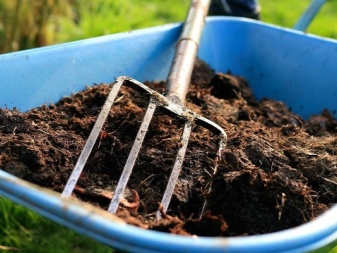
For planting iris rhizome must be well formed, dense and free from decay, with foliage of at least 15 cm... Shoot rudiments are visible with yellowish-green tubercles. The central sheets are dense and green, the side sheets are permissible dried.
Very large roots come from an excess of fertilizing, plants from them are more susceptible to disease. It is not necessary to immediately plant the plant in the front garden, drying is useful for a young bush. Do not store planting material in polyethylene and in a humid environment.


It is important to plant irises correctly... The hole for the bush is made shallow, dry earth is poured with a mound in the middle and the rhizome is laid, carefully distributing the roots on the sides. The thick rhizome is covered with sand on the sides by 2 cm, and the roots are covered with earth. The middle part with leaves remains above the surface. A distance of approximately 50 cm is maintained between tall species, and 30 cm between dwarf species.
Landing scheme:
- chess (at a distance of 50 cm);
- in rows (between the bushes 40 cm);
- around (at a distance of 30 cm).


How to care?
The transplant is done after flowering after one or two weeks. They begin to transplant bearded irises in July and do it until the end of August; in more southern regions, the dates can be postponed until mid-September. At a later date, the plant will not have time to take root and will not be able to overwinter. The bushes are transplanted and divided until the first decade of September. In the middle lane, it is not recommended to delay the landing.
After transplanting, irises are watered, weeded, loosened, fed and pruned.

Basic care for irises.
- Watering... Bearded irises do not like excess moisture in the soil, as they accumulate it in the roots. Water completely dry soil in the evening, trying not to get on the leaves and flowers.
- Loosening. The roots of irises are almost on the surface, so the soil is loosened with care with your hands.
- Top dressing... Held 3 times per season. In the spring, nitrogen fertilizers are applied to stimulate plant growth. In the summer they are fed with ammonium fertilizers and phosphorus. In the fall - phosphorus and potassium to prepare for winter. On fertile soil, fertilization begins in a year or two.
- Pruning... During the flowering period, dry flowers are cut off and the stems are cut, leaving 3 cm from the root. The main pruning is carried out 3.5 weeks after the end of flowering in August, if this variety blooms late in early September. The upper part of the bush is cut with a cone at a height of 14-15 cm from the soil and the roots are covered with dry earth.
- Preparing for winter... In October, before the onset of the first frost, the irises are cut off, leaving only green shoots and leaves. Then they cover it with peat, humus or dry leaves at least 20 cm thick. Before the first snow, dry spruce or pine branches are laid on top. In March, the spruce branches are harvested, and the peat layer around the roots is removed.


Reproduction methods
Bearded irises can only be propagated by dividing the rhizomes; plants obtained from seeds do not retain their decorative properties. It must be remembered that mature plants are replanted after 6 years. The bushes grow and take up all the space around, filling in the gaps between the beds and paths. It is better to dig up an adult plant and separate several younger shoots. For planting, take the growths that appeared in the summer - one-year branches of the rhizome. After flowering, the roots of the bearded iris begin to grow, which means that the transplanted plant will quickly take root. Three weeks after the appearance of the last flower, the iris is allowed to be dug up and divided.
In two-year-old bushes, underground parts grow up to 3.5 cm wide and form 5-7 arrow-shaped leaves. After overwintering, they will bloom next spring. The disadvantage is that they do not tolerate winter well and after a year or two they stop blooming. Recommended for planting annual parts from the rhizome up to 2.5 cm thick with 4 leaves. In the coming spring, these irises will not bloom, but in a year they will delight with the first buds.

How to split iris root.
- Dig out the root thickening.
- Divide with a knife into pieces about 2 cm in length. The resulting pieces should have healthy roots.
- They are washed, and the cut site is disinfected with a solution of potassium permanganate (15 g per 10 liters of water), sprinkled with ash or charcoal.
- The delenka is dried and deepened into the sand by 3 cm.
It is impossible to pull out irises, so you can cut off the leaves, and the rhizome will remain in the ground.


Why bearded irises are divided:
- at 3-4 years, the bushes have a period of abundant flowering, then fades away;
- young parts of the root are located on the surface, where they can freeze;
- the bush grows strongly in breadth;
- old root shoots inside the plant die;
- overgrown irises make it difficult to weed, fertilize and water.

Iris is also propagated by the kidneys.
- The root is dug out of the soil.
- Washed and dried.
- Cut out the parts in the form of a cone with the tip down, inside the rhizome. Each piece retains several roots from an adult plant.
- Slices are sprinkled with coal or ash, dried before planting.
- They are planted in furrows dug 5 cm, covered with earth in half with sand and peat, and watered.
- Rooted shoots that have given leaves will be transplanted into the garden for another year.
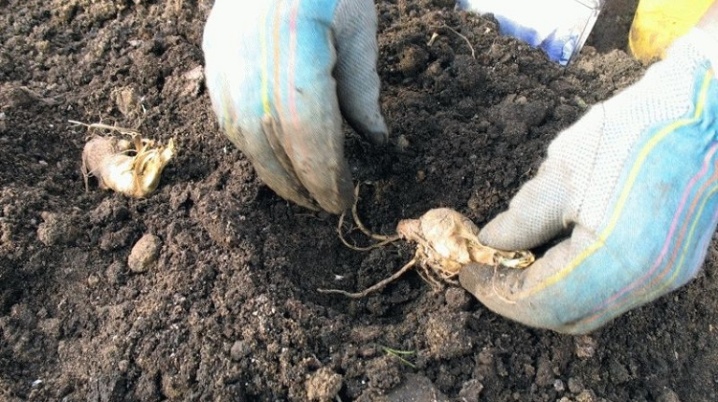
Diseases and pests
The bearded iris does not bloom for various reasons, but most likely the bushes are sick. The most dangerous disease is considered root rot (bacteriosis). It appears on healthy irises in a damp and cool summer or after a warm and damp winter. A symptom of this disease is yellowed and dry leaves prone to the ground. Rot appears at the base of the bush with a characteristic pungent odor.
Treatment: the rhizome is dug up, the decayed areas are cut out to a clean root, sprinkled with "Fundazol", dried in the open air and planted in another place. The rhizome is placed shallowly, slightly sprinkled with dry soil, only thin roots are well covered.
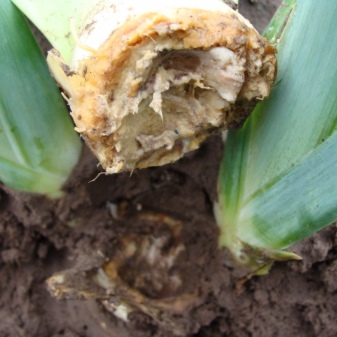

The second dangerous disease is leaf spot. Appears in wet weather. Small spots appear on the leaves, which eventually affect all the leaves, which causes the bush to dry out. The plant does not die, but not receiving enough nutrients, it withers and grows poorly. Sick irises are treated with Quadris or Fitosporin-M. Skroch - this disease cannot be cured. If the foliage on the irises begins to turn brown, the edges dry out, the roots die off, and the thick rhizome hardens, and the plant dries up, it is recommended to dig up the diseased bush and burn it. The area where the bush was located is treated with lime or formalin.
In full bloom, bearded iris may develop iris fly and bronze, and in unopened buds - a deer beetle. Pests live in flowers only. Fighting them comes down to collecting by hand. Early in the morning, bypassing the front garden, they remove pests and destroy them. The raspberry fly lays eggs in the buds of irises, from which larvae appear, which destroy the unblown flowers and the peduncle from the inside. The entire iris branch may never bloom.
An effective method is spraying the buds at the very beginning of their formation with Decis.


Examples in landscape design
Check out this selection of beautiful examples of using irises to decorate the landscape:
- iris gardens are called iridariums;

- against a plain background it is advised to plant two-color and three-color varieties, for example, "Decadence";


- dwarf species are planted in the front garden from the edges, and the taller ones are in the middle;


- single irises are used in the design of rockeries and the foot of rock gardens;

- great for decorating paths in the garden and a cobbled courtyard;


- planted in tall flowerpots along with annuals blooming from July to September;


- designers often use irises in mixed beds with shrubs, conifers and flowers;

- compositions with lilies, poppies, lupins.

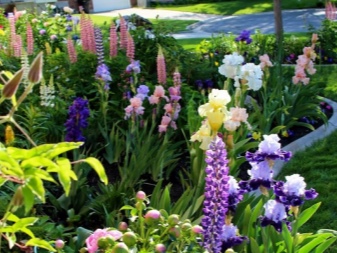
For what novice growers should know about bearded irises, see the next video.







































































































The comment was sent successfully.